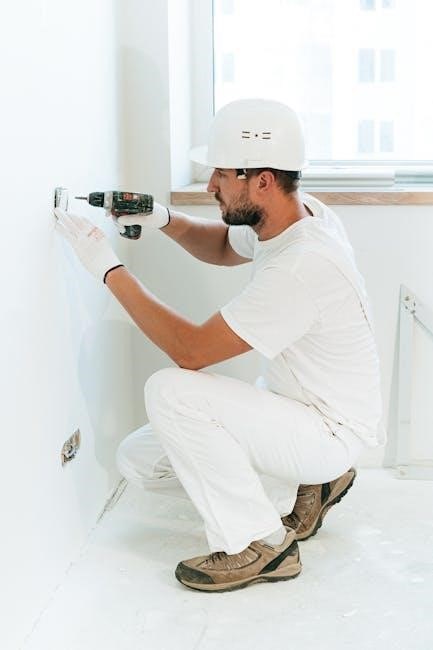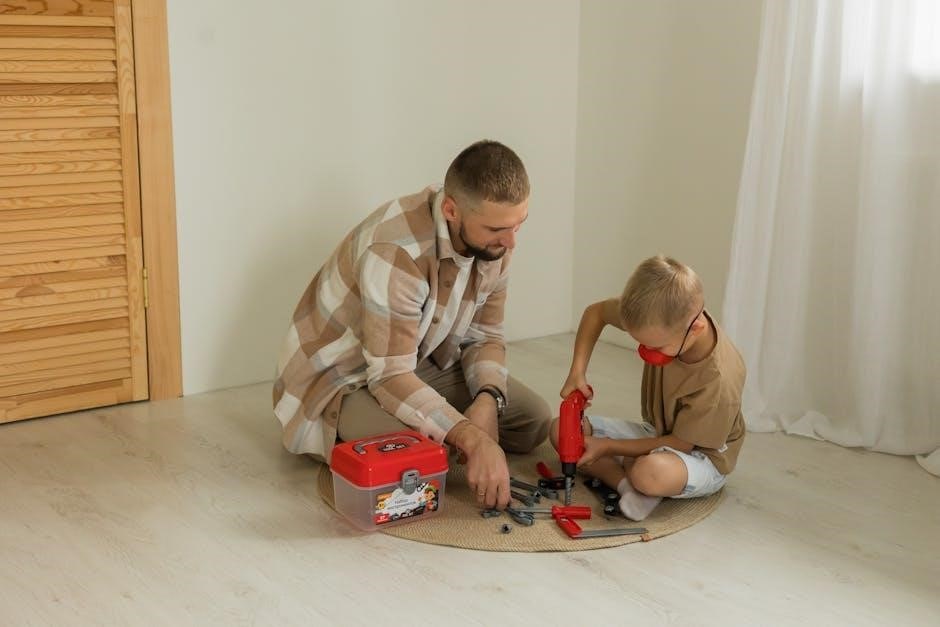block and beam floor installation instructions
Block and beam flooring offers a efficient, durable solution for creating level surfaces. It combines precast concrete beams with infill blocks, ensuring structural stability and versatility.
1.1 Overview of Block and Beam Flooring
Block and beam flooring is a popular construction method using precast concrete beams and infill blocks. It provides a durable, level surface, ideal for residential and commercial buildings. Beams are placed at intervals, with blocks filling the gaps, ensuring strength and stability. This system is known for its speed of installation, thermal efficiency, and minimal maintenance, making it a versatile choice for various flooring needs.
1.2 Advantages of Beam and Block Flooring
Beam and block flooring offers durability, stability, and speed of installation. It provides excellent thermal efficiency and minimizes maintenance. The system is cost-effective, suitable for various applications, and ensures a level surface. Its precast components enable quick assembly, reducing construction time. Additionally, it supports heavy loads and is resistant to moisture, making it ideal for both residential and commercial projects.

Site Preparation for Block and Beam Installation
Site preparation involves proper excavation, leveling, and foundation setup. A damp-proof course is laid to prevent moisture issues, ensuring a stable base for beams and blocks.
2.1 Ground Excavation and Leveling
Ground excavation involves removing soil to the required depth, ensuring the site is clear and level. Proper leveling is critical for a stable base, preventing future structural issues. A well-prepared surface ensures beams and blocks sit evenly, maintaining the integrity of the floor system. Additionally, a 150mm void and damp-proof course are essential for moisture protection and structural stability.
2.2 Damp Proof Course Installation
A damp-proof course (DPC) is essential to protect the block and beam flooring from moisture damage. It should be laid continuously beneath the beam ends, ensuring a minimum void of 150mm between the floor soffit and the ground. The DPC prevents rising damp and ensures a dry, stable base for the flooring system. Proper installation is critical to maintain structural integrity and prevent long-term damage.
2.4 Foundations and Bearing Surfaces
Proper foundations and level bearing surfaces are critical for block and beam installation. Beams must be placed on suitable solid and level bearings to ensure structural stability. A minimum bearing of 90mm is required for beams, and the surface must be even to prevent uneven load distribution. Foundations should be designed to support the combined weight of the beams, blocks, and intended floor loads, ensuring long-term durability and preventing potential structural issues.

Beam Placement and Alignment
Beams must be precisely positioned according to layout drawings, ensuring proper alignment and levelness. Secure beams with mortar beds to maintain stability and structural integrity during installation.
3.1 Positioning Beams According to Layout Drawings
Beams must be positioned strictly according to the layout drawings, ensuring accurate alignment with the building’s design. Use mechanical lifting equipment to place beams, checking their alignment with spirit levels. Secure beams in their final positions using a mortar bed for stability. Ensure all adjustments align with the specified layout, and verify beam spacing and orientation before proceeding. Any deviations must be approved by the project manager or structural engineer.
3.2 Ensuring Level and Plumb Beams
Use a spirit level to ensure beams are perfectly horizontal and vertical. Check alignment repeatedly during placement, adjusting beams as needed. Use mechanical lifting equipment to reposition beams for accuracy. Once beams are in place, verify their levelness and plumbness again. Make fine adjustments using packing material if required. Ensure beams are stable and correctly aligned before securing them with mortar to maintain structural integrity and prevent future issues.
3.3 Securing Beams with Mortar Bed
A mortar bed ensures beams are securely fastened. Apply a layer of cement/sand mortar beneath each beam, spreading evenly. Press beams firmly into place, ensuring full contact. Use a level to confirm alignment. Allow mortar to cure completely before proceeding. This step provides stability, prevents movement, and enhances structural integrity. Proper curing ensures a strong bond between beams and their bearings, supporting long-term durability. Always follow mix ratios for optimal results.

Block Installation and Infill
Infill blocks are placed between beams, ensuring proper alignment and fit. Blocks are securely positioned, and any necessary cuts are made for services or obstructions. Mortar beds edge blocks for stability and a smooth finish.
4.1 Placing Infill Blocks Between Beams
Infill blocks are carefully placed between the beams, ensuring proper alignment and fit. Blocks must be positioned to maintain structural integrity, with cuts made as needed for services or protrusions. Edge blocks are bedded with mortar to secure them firmly in place, creating a stable base for further construction. Properly aligned and fitted blocks ensure a solid foundation for the floor system and prevent future issues.
4.2 Cutting Blocks for Services and Protrusions
Cutting infill blocks may be necessary to accommodate services or structural protrusions. Precise measurements ensure proper fitment without compromising structural integrity. Blocks are typically cut using a masonry saw, and edges are smoothed to avoid sharp surfaces. After cutting, blocks are carefully fitted around pipes or protrusions, ensuring minimal gaps. Any excess material is removed to maintain a clean and secure installation, preventing potential weaknesses in the floor system.
Edge blocks are bedded with mortar to ensure a secure and even fit. Apply a layer of mortar to the bearing surfaces, then carefully position the blocks. Press firmly to achieve full contact, ensuring no gaps remain. Excess mortar is removed, and the blocks are allowed to cure completely before proceeding. This step is crucial for maintaining structural integrity and preventing movement or cracks in the floor system.

Wet Works and Grouting
4.3 Bedding Edge Blocks with Mortar
Edge blocks are secured with mortar to ensure stability and alignment. Apply a layer of mortar to the bearing surface, press the block firmly into place, and remove excess mortar. Allow the mortar to cure completely before proceeding. This step is essential for maintaining structural integrity and preventing movement or cracks in the floor system.
5.1 Mixing and Applying Cement/Sand Slurry
Mix cement and sand in a 1:6 ratio to create a slurry. Apply evenly between beams and blocks to ensure proper bonding. Use a trowel to spread the mixture, filling gaps completely. Allow the slurry to cure before proceeding with grouting or concrete topping. This step is critical for creating a strong bond and ensuring the structural integrity of the floor system.
5.2 Grouting Beams and Blocks
Grouting beams and blocks involves filling gaps with a cement/sand slurry to ensure a strong bond. Apply the grout using a trowel or brush, pressing firmly into joints. Make sure all spaces are filled to prevent weak spots. Allow the grout to cure fully before proceeding, as proper bonding is essential for structural integrity and a stable floor system.
5.3 Applying Concrete Topping
After grouting, a concrete topping is applied to create a smooth, even surface. Mix the concrete as per instructions, ensuring proper consistency. Spread evenly over the beams and blocks using a trowel or screed. Finish with a smooth surface, feathering edges where necessary. Allow the topping to cure fully before further construction, ensuring it achieves the required strength for load-bearing and durability.
Safety Precautions and Tools
Ensure safety with PPE: hard hats, gloves, and eyewear. Use mechanical aids like forklifts or hoists, with forks spaced at least 1m apart. Inspect equipment regularly.
6.1 Personal Protective Equipment (PPE)
Essential PPE includes hard hats, safety glasses, gloves, and steel-toe boots. High-visibility vests enhance visibility on-site. Proper handling of lifting equipment and regular checks ensure safety. Always wear PPE to minimize risks during installation.
6.2 Mechanical Lifting Equipment Requirements
Mechanical lifting equipment is essential for handling heavy blocks and beams. Forklifts or cranes with lifting points within 300mm of each beam end are recommended. Ensure lifting equipment is properly maintained and operated by trained personnel. Manual handling should be minimized, with proper techniques used when unavoidable. Always follow manufacturer guidelines and safety protocols to prevent accidents during installation.
6.3 Site Safety Practices
Ensure the site is clear of debris and tripping hazards. Properly stack materials to prevent instability. Use lifting equipment correctly, adhering to load limits. Maintain safe working platforms and access routes. Ensure all personnel are trained in handling precast components. Regularly inspect equipment and tools. Follow the Code of Practice for Safe Erection of Precast Concrete Flooring to minimize risks and ensure a secure working environment.
Quality Control and Inspection
Quality control ensures beam alignment, grout application, and design compliance are verified. Regular inspections during installation and a final check before use are essential.
7.1 Checking Beam Alignment and Levelness
Ensure beams are precisely aligned and level using spirit levels and string lines. Proper alignment prevents structural issues and ensures a stable surface. Verify beams are plumb and evenly spaced, adhering to design specifications. Misalignment can lead to uneven surfaces or cracking. Use mechanical lifting equipment carefully to avoid shifting beams during inspection. Precision in this step is critical for long-term durability and safety.
7.2 Verifying Grout and Concrete Application
Inspect grout and concrete application to ensure proper bonding and coverage. Verify the mix ratio of 1:6 for cement/sand slurry is maintained. Check for uniform grout distribution between beams and blocks. Concrete topping must be evenly applied and cured as specified. Ensure no gaps or weaknesses remain, as these can compromise structural integrity. Proper curing ensures long-term durability and stability of the floor system.
7.3 Final Inspection Before Use
A thorough final inspection ensures the floor meets safety and structural standards. Check for any surface flaws, gaps, or unevenness. Verify beams and blocks are securely bonded and level. Ensure all protrusions are properly sealed and no safety hazards exist. Document any defects and address them before use. This final check guarantees the floor is safe, stable, and ready for occupancy or further construction activities.
